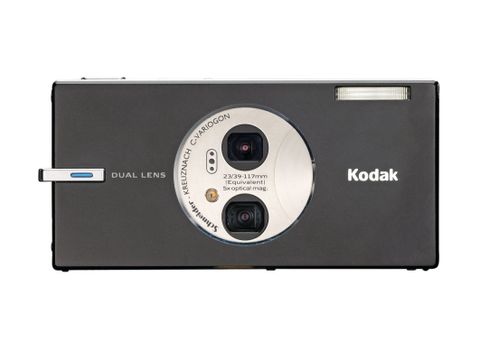TechRadar Verdict
The V705 makes a stand for innovation, style and sheer egg-head lunacy
Pros
- +
Ultra-wide focal lengths
Bright, well-exposed and colourful images
Value for money
Cons
- -
Grainy, mushy and imprecise images
Zoom rocker is small
The processing delays are intrusive
Controls seem designed for style over function
Why you can trust TechRadar
If double vision is something that kicks in after a few pints, it would come as no surprise to hear that Kodak's camera designers have been hitting the bottle.
The V705 is a terrifically strange piece of kit, boasting two lenses - one fixed focus ultra-wide-angle; the other a standard 3x autofocus zoom - and two identical 7.1MP sensors, all wrapped up in a stylish black-and- silver metal case.
Squeeze the recessed power switch and the Kodak's circular lens cover slips aside to reveal the two lenses, smaller than you'll be used to from other compacts and mounted over-and-under like two thirds of a traffic light.
Each lens has its own optical path to its own 7.1MP sensor, although you'd never know that from behind the camera. Here, you're presented with a standard 2.5-inch LCD, zoom rocker, menu joystick and a few dedicated controls.
The screen is bright and colourful, though very grainy, even in normal indoor conditions. There's no complexity involved in choosing a lens - the digital camera defaults to the ultra-wide (upper) lens and then you simply zoom in to swap, almost instantly, to the (lower) 3x zoom.
Beware the 'optical gap' between the (23mm) ultra-wide and the widest focal length (39mm) of the zoom. Unless you deselect digital zoom in the set-up menu, the V705 fills this range by digitally zooming the ultra-wide image. Unfortunately, the only time you might actually want the digital zoom - when you're shooting smooth, sharp VGA movies - it automatically disables.
Star feature
The 23mm ultra-wide lens is the star feature of the V705. It enables the extended group portraits, wide-open landscapes and architectural studies that compacts have traditionally been so poor at capturing, with a minimum of distortion and virtually no purple fringing.
However, you do need to think about your subjects. For everything beyond about 30cm the lens will be sharp but there's no blur warning if you stray nearer - often a temptation when experimenting with weird close-ups. A fun in-camera Stitching mode enables 180-degree panoramas with just three frames.
Because there's no autofocus system to wait for with the wide-angle lens, shutter response is lightning fast. The Kodak does slow down when processing and saving images though, and is prone to blacking out the LCD completely if you attempt to shoot photos in quick succession. In this case, choose the reliable seven-frame Burst mode, which runs at 2.5fps.
Flip over to the 3x zoom lens and the V705 loses much of its lustre. It now looks and handles like just another simple point-and-shoot snapper, albeit one with lots of scene modes and useful exposure or focus adjustments. The autofocusing is smart, fast and gives good feedback, so you always know exactly where the Kodak is looking.
So do two sensors make the Kodak's photos twice as nice? Hardly. If anything, squeezing two full optical systems into one compact device is more likely to halve picture quality than double it. Luckily, things aren't quite that bad. While neither lens captures the finest details or avoids softness towards the edges, they both deliver strong, authentic colours and benefit from a confident metering system.
Noise is an issue at ISO 400 and above, but remember that an ultra-wide lens will bear slower shutter speeds without risking camera shake. Overall, low-light performance is surprisingly good, thanks to a powerful flash and well-judged slow sync exposures. There isn't even too much drop-off of light at the very corners when shooting ultra-wide.
The V705 looks peculiar, only takes average photos and, as easy to use as the dual lenses are, they still risk sending novice users cross-eyed. But, if you want a stylish, well-built second camera for ultra-wide landscape and funky party shots, it's hard to think of another camera that fits the bill.
Via PhotoRadar
Tech.co.uk was the former name of TechRadar.com. Its staff were at the forefront of the digital publishing revolution, and spearheaded the move to bring consumer technology journalism to its natural home – online. Many of the current TechRadar staff started life a Tech.co.uk staff writer, covering everything from the emerging smartphone market to the evolving market of personal computers. Think of it as the building blocks of the TechRadar you love today.

